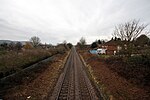Downfield Crossing Halt railway station
1903 establishments in England1964 disestablishments in EnglandBeeching closures in EnglandDisused railway stations in GloucestershireFormer Great Western Railway stations ... and 5 more
Pages with no open date in Infobox stationRailway stations in Great Britain closed in 1964Railway stations in Great Britain opened in 1903Stroud DistrictUse British English from August 2017

Downfield Crossing Halt was on what is now the Golden Valley Line between Stroud and Stonehouse.
Excerpt from the Wikipedia article Downfield Crossing Halt railway station (License: CC BY-SA 3.0, Authors, Images).Downfield Crossing Halt railway station
Beards Lane,
Geographical coordinates (GPS) Address Phone number Website Nearby Places Show on map
Geographical coordinates (GPS)
| Latitude | Longitude |
|---|---|
| N 51.746 ° | E -2.2348 ° |
Address
Stroud High School
Beards Lane
GL5 4HF , Stroud
England, United Kingdom
Open on Google Maps





